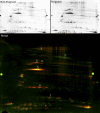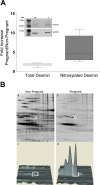Uterine smooth muscle S-nitrosylproteome in pregnancy
- PMID: 22027755
- PMCID: PMC3263952
- DOI: 10.1124/mol.111.075804
Uterine smooth muscle S-nitrosylproteome in pregnancy
Abstract
The molecular mechanisms involved in uterine quiescence during gestation and those responsible for induction of labor are not completely known. Nitric oxide relaxes uterine smooth muscle in a manner disparate from that for other smooth muscles because global elevation of cGMP after activation of soluble guanylyl cyclase does not relax the muscle. S-Nitrosylation, the covalent addition of an nitric oxide (NO) group to a cysteine thiol is a likely mechanism to explain the ability of NO to relax myometrium. This work is the first to describe the myometrial S-nitrosylproteome in both pregnant and nonpregnant tissue states. Using the guinea pig model, we show that specific sets of proteins involved in contraction and relaxation are S-nitrosylated in laboring and nonlaboring muscle and that many of these proteins are uniquely S-nitrosylated in only one state of the tissue. In particular, we show that S-nitrosylation of the intermediate filament protein desmin is significantly increased (5.7-fold, p < 0.005) in pregnancy and that this increase cannot be attributed solely to the increase in protein expression (1.8-fold, p < 0.005) that accompanies pregnancy. Elucidation of the myometrial S-nitrosylproteome provides a list of mechanistically important proteins that can constitute the basis of hypotheses formed to explain the regulation of uterine contraction/relaxation.
Figures



References
-
- Behrman RE, Butler AS, editors (2006) Preterm Birth: Causes, Consequences, and Prevention, National Academies Press, Washington, DC - PubMed
-
- Bradley KK, Buxton IL, Barber JE, McGaw T, Bradley ME. (1998) Nitric oxide relaxes human myometrium by a cGMP-independent mechanism. Am J Physiol 275:C1668–C1673 - PubMed
-
- Buhimschi C, Buhimschi I, Yallampalli C, Chwalisz K, Garfield RE. (1997) Contrasting effects of diethylenetriamine-nitric oxide, a spontaneously releasing nitric oxide donor, on pregnant rat uterine contractility in vitro versus in vivo. Am J Obstet Gynecol 177:690–701 - PubMed
-
- Buxton IL. (2004) Regulation of uterine function: a biochemical conundrum in the regulation of smooth muscle relaxation. Mol Pharmacol 65:1051–1059 - PubMed
-
- Buxton IL, Crow W, Mathew SO. (2000) Regulation of uterine contraction: mechanisms in preterm labor. AACN Clin Issues 11:271–282 - PubMed
Publication types
MeSH terms
Substances
Grants and funding
LinkOut - more resources
Full Text Sources

